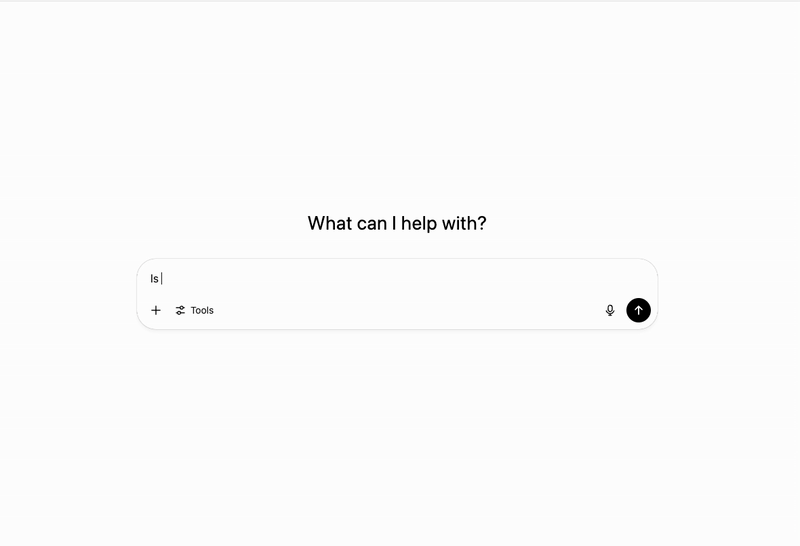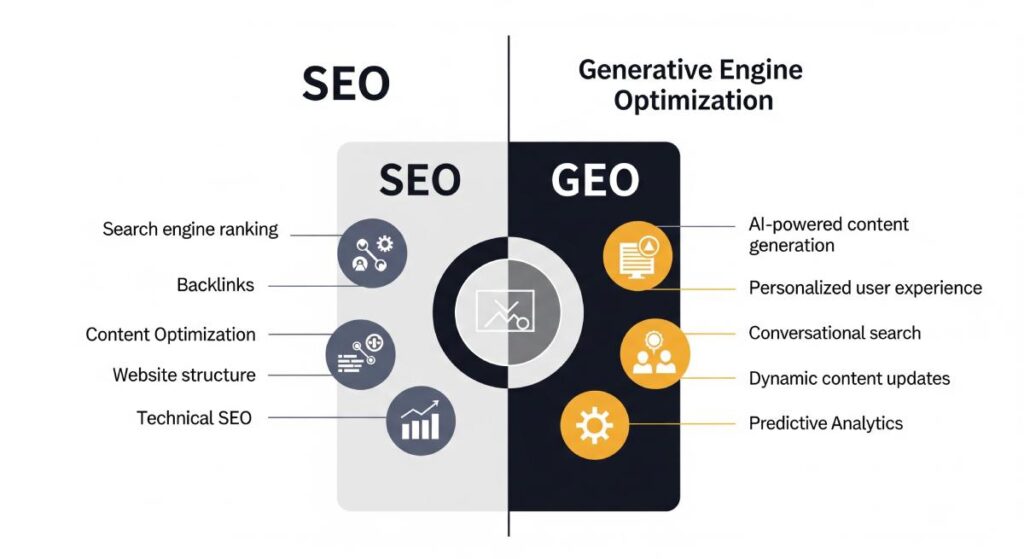TL;DR: Generative Engine Optimization (GEO) is the next evolution of SEO. As more people turn to AI tools like ChatGPT, Bing Copilot, and Google’s AI-powered search for quick, conversational answers, your content must be easy for AI to understand, surface, and trust.
It’s not about replacing SEO. It’s about enhancing it with smarter, more structured content that works across both search and AI platforms.
The brands that start adapting now will be the ones AI recommends tomorrow. Ready to future-proof your content strategy? Let’s get started.
So, what exactly is GEO? Let’s start by asking ChatGPT…
What is GEO – Generative Engine Optimization?
I asked ChatGPT what GEO is…
Q: What is GEO or Generative Engine Optimization?
A: GEO is like the next level of SEO. Instead of just trying to show up on Google, you’re also making sure your content is easy for AI tools, like ChatGPT, Bing Copilot, and Google’s AI search, to find and share. As more people turn to these tools for answers, businesses that show up in those responses are more likely to stay visible and ahead of the game.
Then, I asked our Chief Strategist what GEO is…
“Basically, instead of just optimizing for Google, we now have to optimize to make a different algorithm happy and appear in Generative Engines that are becoming increasingly popular, such as ChatGPT.” – Jonathan Gessert, CEO, 321 Web Marketing
The role of an SEO strategist has expanded to include optimization for Generative Engines. To ignore these marketing channels would be akin to ignoring Google, Yahoo, and Bing in the mid-2000s.
Do You Need to Worry About GEO?
We get asked about AI all the time, but mostly in the context of “should we use AI to generate content?”
Short answer: Ask photographers if they should use Photoshop to touch up their photos.
Long answer: AI has a lot of novel uses beyond spitting out text. Generative Engines are one of the most powerful business tools ever created and are used by organizations every day to create content, answer questions, write code, perform complex computations and analysis, and much more.
For many, Generative Engines are simply a way to get answers to questions more directly than navigating through websites in a Google search. Google is aware of this and has started adding Generative Engine answers directly at the top of their search for this reason.
How Is GEO Used Today?
Anecdotely, it hasn’t replaced search engines for many types of searches. It has just become a new marketing channel in and of itself that people use on top of research in online forums, company websites, directories, and review sites.
If your potential customers are searching for answers, make sure they find your answer. Especially for searches such as “who are the top 10 companies in X?” or “Is company Y a reputable company?”

How do you do this? The same way you win SEO: Increase your online footprint so that Generative Engines understand your company and brand.
How is GEO Different from SEO?
Traditional SEO and Generative Engine Optimization (GEO) serve similar goals but work differently based on the platforms they target:
| Category | Traditional SEO | GEO |
|---|---|---|
| Purpose | Optimizes content to rank higher on search engines like Google. | Optimizes content for AI tools like ChatGPT, Bard, and Gemini for direct, conversational answers. |
| User Experience | Delivers ranked links on search engine results pages (SERPs). | Provides immediate, AI-generated answers without requiring a click-through. |
| Optimization Focus | Emphasizes keywords and backlinks. | Emphasizes structured, context-rich, and semantically helpful content. |
| Algorithm Behavior | Functions as a ranking algorithm surfacing the most relevant websites. | Acts as a synthesis tool, pulling detailed answers from multiple sources. |
| Content Objective | Drives clicks and website visits from SERPs. | Aims for brand mentions or citations within AI-generated summaries. |
Click-through rates to websites is the goal with SEO, where capturing mentions or recommendations in AI summaries is key to GEO success.
What Are The Key Elements of a GEO Campaign?
You can use specific strategies to succeed with GEO, many of which overlap with traditional SEO. This overlap is beneficial; it means you don’t need to manage two entirely separate campaigns.
In fact, advancements like AI are helping boost all forms of inbound marketing, including GEO. How do you compete?
As seen in the list above, many of these strategies are likely already in place if you are running a successful SEO campaign.
So, let’s discuss these from a more GEO perspective.
Create Clear and Helpful Content
AI tools are simply faster ways of getting answers to questions. Instead of listing a bunch of ads and organic links, AI delivers answers to a question.
As a result, now more than ever, your organization must create clear and useful content. Google has consistently emphasized the importance of helpful content in its many instructional articles about Google E-E-A-T – experience, expertise, authoritativeness, and trustworthiness.
Google continuously stresses the importance of helpful content in articles and their Quality Ratings Guideline – a tool they give to quality rating experts to help them judge the effectiveness of search results.
AI relies on content it finds across the internet to answer questions from its users, relying on real content from real sources in the answers provided. This means, the better and more helpful your content is, the more likely AI will select it to answer the questions of your customers.
Become a Trusted Expert in Your Niche
However, like SEO, having quality content isn’t enough to get your content into the answers that AI gives your prospective customers. AI seeks evidence that your content is reliable.
This brings us back to Google E-E-A-T: specifically regarding the A and T, authoritativeness and trustworthiness. Google is saying they need proof your content is trustworthy and truly helpful.
Google won’t take your word for it, and neither will AI; they require proof. This can be demonstrated in backlinks from authoritative sources, positive reviews in sites like Clutch or others, and mentions in trustworthy websites.
Being endorsed across a wide variety of websites illustrates your authoritativeness and helps with SEO and GEO.
These accolades are not freely given; you can earn them over time, but it takes strategic effort. An inbound marketing campaign should always consist of the following to build trust:
- PR campaigns
- Backlinking outreach
- Podcast interviews featuring your thought leaders
- Outreach to high-authority blogs, review sites, and magazine sites asking for mentions to thought leadership content you’ve created
Having diverse content such as blogs, service pages, case studies, whitepapers, infographics, and podcasts will help to improve your backlinks, your credibility (to Google, AI, and your audience), and show that you’re delivering more than a series of mundane blog posts.
Nothing happens in a vacuum. True growth happens with a strategic effort, whether internally, or with a trusted inbound marketing team, like 321.
Use Formatting That AI Understands
Similar to SEO, AI engines tend to favor content that is structured and coded in ways that make it easy to understand and use for generating answers.
The good news? If your SEO strategy is strong, many of these practices should already be in place. If you’re unsure, ask your digital marketing team to confirm that the following elements are implemented and functioning as they should:
- Structured Content – Use clear headings (H1, H2, H3) to define topics. Break up text into short, digestible paragraphs.
- Bullet Points & Lists – AI models often pull from bullet points or numbered lists because they’re concise and easy to summarize, like this one.
- FAQ Sections – Including questions and answers improves the chance of your content showing up when users ask similar questions with AI tools.
- Schema Markup – Schema is code that helps search engines and AI understand the content and context of your page.
- Clear Language – Favor clarity over technical or complicated terms. Make your content clear, helpful, and easy for AI and your audience to understand.
You might want to also consider adding the following:
- Key Takeaway Sections – Implement a quick TL;DR / Sparknotes of an article, placed above the intro paragraph. (like the one above)
- “Updated On” Statements – If an article has been updated/optimized since its original posting date, notate the last date an update was made at the top or bottom (top preferably).
- Multimedia – Using infographics or videos can help generative engines gain a better understanding of the content as a whole.
Again, all of these efforts also work toward SEO success. Even if AI is not a concern for you (though it should be), these techniques must still be a part of your inbound lead strategy.
Track How AI Tools Mention Your Brand
The right strategy includes keeping tabs on your performance through regular check-ins, but monitoring brand mentions within generative AI tools is still an emerging practice and isn’t as simple as tracking traditional SEO metrics; at least not yet.
However, getting ahead of the curve by adopting these practices early can give your brand a strong competitive edge.
For now, the most effective approach is a combination of the following activities:
- Manually test AI platforms to see how/if your brand shows up in generated responses
- Monitor online citations and backlinks that AI may pull data from, similar to SEO
- Track referral traffic from AI tools like ChatGPT, Claude, and Gemini
- Build your content’s authority and structure to increase references
More advanced tools for measuring AI visibility will emerge as generative engines evolve, and businesses that act now will be better positioned to lead the conversation and win early visibility in these channels.
GEO Is Not Going Away
If you think none of this applies to you, think back to the early days of the internet when businesses didn’t see the point of having a website. Seems silly now, but then it wasn’t such a crazy idea.
The same can be said for generative engine optimization. If you’re not on board with this new inbound marketing strategy, your competitors may likely be. And, if they’re not, wouldn’t you like to beat them to the punch?







